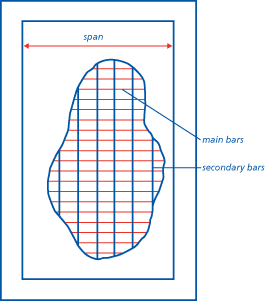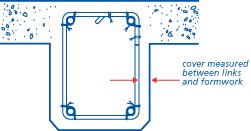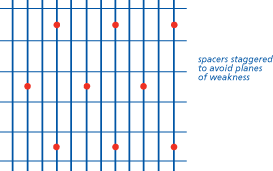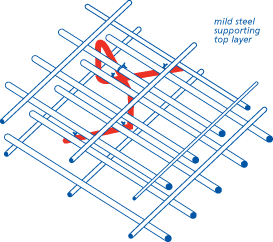2.1 Concrete and its reinforcement
SITEWORK STANDARDS
(a) meet the Technical Requirements
(b) take account of the design
(c) follow established good practice and workmanship
Sitework that complies with the design and the guidance below will be acceptable for the use of concrete and its reinforcement.
Adequate concrete performance depends as much on how the cured concrete element is produced as on the composition of the concrete.
STORAGE OF MATERIALS
Where materials need to be stored, the following precautions should be taken:
- store cement in a dry place
- store each type of cement separately
- follow the cement manufacturer's recommendations on maximum storage time
- store different sizes of aggregate in separate bays
- keep sand and aggregate clean
- keep sand and aggregate dry - where this is not possible, allowance must be made in the concrete batching for moisture in the sand and aggregate.
For precautions during cold weather, reference should be made to Chapter 1.4 'Cold weather working'.
BLINDING CONCRETE
Blinding concrete should only be used in the following situations:
- to protect the bottom of the trench/excavation if there is a delay in pouring structural concrete
- to provide sufficient support to ensure cover to reinforcement is maintained
- where the foundation has been slightly overdug
- where localised soft spots have been removed.
FORMWORK
Items to be taken into account include:
(a) setting out
Where formwork is necessary, it should be set out in relation to relevant reference lines and benchmarks. Accuracy is essential to ensure that the cover to the reinforcement is as specified.
(b) support of working loads
The formwork and its supports should be rigid enough to maintain the correct position and to withstand all extra loads and accidental knocks likely to occur when concrete is placed and compacted.
Wedges, inserts and boxes should be firmly secured to avoid displacement during vibration.
(c) finish
For concrete which is to be left untreated or with minimum finishing, the tightness of formwork joints is particularly important to avoid grout loss and resulting ragged edges.
Joints between shutters should be constructed for easy stripping.
Any holes for bolts or spacers should be drilled with care to avoid disfiguring or splintering the formwork surface and giving a poor finish.
(d) striking
Formwork should be capable of being struck without damage to the concrete.
Formwork should be dismantled without shock, disturbance or damage to the concrete. Support for loadbearing elements should not be removed until the concrete has achieved sufficient strength, as detailed by the designer.
Props under suspended floors or beams should be released from the centre, outwards to avoid overloading.
REINFORCEMENT
Items to be taken into account include:
(a) condition of reinforcement
Check that reinforcing bars are clean, and free from loose rust and contaminants (especially shutter releasing agents and oils) before, during and after placement.
(b) shape of bars
Site bending should be carried out with the proper machinery for the job, whether hand-operated or powered.
(c) placing of bars
Bars should be bent and placed as shown on the drawings.
Reinforcement should be laid so that the main reinforcing bars are parallel to the span or as detailed in the design.
Slab reinforcement should be located near the bottom of the slab, with the main reinforcing bars usually placed first and the secondary bars on top. For beams, the main reinforcing bars should be placed inside the links.

(d) lapping bars and mesh
Reinforcing bars or mesh should always be lapped in accordance with their size and type, as indicated by the designer, to ensure that the loading is fully transferred across the lap. Any additional laps require the designer's approval.
(e) cover for bars
Particular attention should be given to maintaining adequate cover for the reinforcement, especially for concrete in exposed positions or in the ground. Check that the cover is adequate for stirrups as well as for the main bars, and that no ties or clips protrude into the cover.

(f) support of reinforcement
Cover spacers should be made of concrete (eg broken concrete paving slabs) or ready made of steel or plastic. Concrete cover spacers should be not more than 50 x 50mm.
Supports should be placed not more than one metre apart or closer where necessary.
Spacers for parallel bars should be staggered to avoid creating a plane of weakness in the concrete.

Supports for top steel should be chairs (or other proprietary products).

For details of reinforcement for suspended ground floor slabs, reference should be made to Chapter 5.2 'Suspended ground floors' (Design).
Before concreting starts, all services, ducts, inserts, etc to be embedded in the concrete should be installed and, where appropriate, tested.
All inserts, box-outs, cast-in fixings, etc should be checked for correct positioning and secured.
The formwork should be cleaned out and checked for fallen debris, especially nails and wire clippings. The completed reinforcement should be checked and, where necessary, approved by the designer or his representative.
READY-MIXED CONCRETE
When ordering ready-mixed concrete all requirements according to the design, including reference to Appendix 2.1-A, should be specified.
The concrete should be a GEN mix, FND mix or RC mix ordered in accordance with Appendix 2.1-A Tables 1 and 4b.
Check the delivery ticket to ensure that the concrete meets the requirements given in the design.
ON-SITE CONCRETE MIXING
Items to be taken into account include:
(a) mixing methods
Except for very small quantities, a mechanical mixer should be used. If hand mixing, add an extra 10% of cement to the quantities shown in Tables 2a and 2b in Appendix 2.1-A.
(b) admixtures
Admixtures should be used only where permitted in the specification. Dosages should be strictly in accordance with the manufacturer's instructions and should be tested in trial mixes, where necessary. Admixtures should, wherever possible, be added to the mix water to ensure complete dispersal.
Do not overdose concrete with admixtures - use the correct dosage.
Plasticizers can improve concrete cohesion and the bond with reinforcement.
Air entraining agents increase the air void content of the cured concrete and can help produce a more frost resistant surface. They are recommended for paths, drives and pavements which are likely to be exposed to freezing conditions.
Accelerators produce early setting of the concrete. No admixture should be relied upon as an anti-freeze for fresh concrete. For details about concreting at low temperatures, reference should be made to Chapter 1.4 'Cold weather working'.
Admixtures containing chlorides can cause metal corrosion and should never be used in reinforced concrete.
TESTING
Where testing is necessary to ensure that concrete is to the strength required by the design, ie with Designed mixes, UKAS approved laboratories should be used.
Concrete test cubes should be prepared as requested by the Engineer. These should be marked, cured and stored safely until testing. Tests should be carried out in accordance with BS EN 12390.
Proof of testing with reports and certificates, should be kept for later reference. Proof of testing, with allied documentation, should be made available to NHBC upon request. A ready-mix concrete supplier should take test cubes, as required, for his quality assurance procedures.
CASTING
Items to be taken into account include:
(a) transportation
Concrete should be deposited as close as possible to its final location. Transportation on site should be as fast and efficient as possible in order to avoid segregation and to ensure full compaction of the placed concrete.
(b) low temperatures
The temperature of the concrete at the point of use should not be less than 5°C (41°F).
Fresh concrete is susceptible to frost damage. Freezing can cause internal damage that is not immediately obvious. During cold weather, either stop working or follow the recommendations given in Chapter 1.4 'Cold weather working'.
(c) placing
Site-mixed concrete should be placed within 30 minutes, and ready-mixed concrete within 2 hours, of water being added to the cement.
Additional water should not be added to ready-mixed concrete unless under the supervision and approval of the supplier. Concrete should not be placed in or under water, unless it has been specially designed for that use.
Concreting should, wherever possible, be carried out in one operation, taking account of:
- weather conditions,
- available daylight, and
- time to allow for surface finishing.
(d) avoiding construction joints
Concrete cast in one operation (ie without construction joints) should not be greater than the following, and should always be as square in shape as possible:
- reinforced concrete 60m2
- unreinforced concrete 16m2.
Sufficient concrete should be mixed/ordered, so that it can be placed in a continuous process. Construction joints should be formed only if unavoidable and then in consultation with the Engineer. Before work continues beyond the joint, all shuttering should be removed.
(e) joints in foundations
Joints should not be positioned next to a return in the foundation.
(f) compaction
Concrete should be consolidated according to the design and specification requirements.
Reinforced concrete should be fully compacted using poker vibration unless the design states otherwise. Poker vibration should be carried out by experienced operators to ensure complete coverage and avoid honeycombing.
Vibrating beams or hand tamping may be used to consolidate slabs up to 150mm thick, unless the design details otherwise.
Excessive use of vibration can cause segregation and prevent concrete reaching an adequate strength.
(g) protection after placing
Freshly poured concrete should be kept moist by covering as soon as the surface is hard enough to resist damage. This is particularly important in hot, windy or cold weather to prevent the surface drying out too rapidly or freezing. Damp hessian, damp sharp sand or an impervious sheet (such as polyethylene) are acceptable as surface coverings. An alternative is to apply a curing agent to the surface of concrete.
CURING
Check the design to see if there are any special requirements for curing concrete.
No load should be allowed on the work until the concrete has cured sufficiently.
It is recommended that plain unreinforced concrete made with ordinary Portland cement is left for at least 4 days to cure. It is possible to proceed with substructure masonry above strip or trench fill foundations on unreinforced ordinary Portland cement concrete at an early stage, provided care is taken to protect the surface from damage.
Reinforced concrete, or concrete containing cement replacements, such as PFA, will require a longer curing period. This will normally be 7 days and the concrete structure should not be loaded during this period.
Any curing agents should comply with Technical Requirement R3 and should be applied strictly in accordance with the manufacturer's instructions. Curing agents should never be used on floors which are to receive either a topping or a screed, as it could affect the future bond.
Curing periods may be extended at low temperatures, as described in Chapter 1.4 'Cold weather working'.





















